Microsoft 70-332 Exam Practice Questions (P. 4)
- Full Access (127 questions)
- Six months of Premium Access
- Access to one million comments
- Seamless ChatGPT Integration
- Ability to download PDF files
- Anki Flashcard files for revision
- No Captcha & No AdSense
- Advanced Exam Configuration
Question #16
You are designing a SharePoint search solution.
The search solution must meet the following requirements:
Run search queries against specific SharePoint columns.
Run search queries against specific document properties.
You need to ensure the search solution meets the requirements.
What should you do? (To answer, select the appropriate option from each drop-down list in the answer area.)
Hot Area:
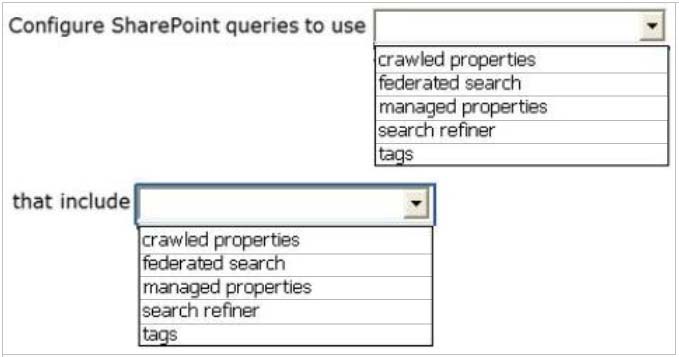
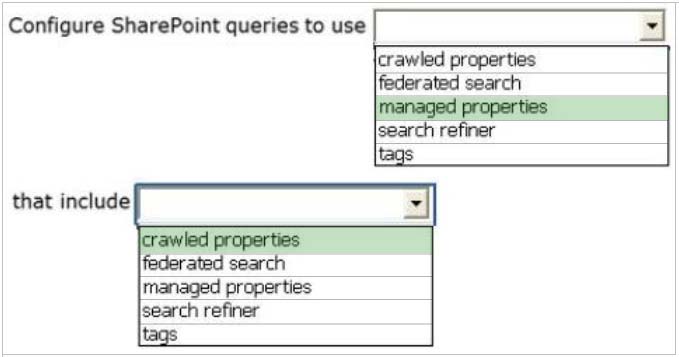
Note:
* To include the content and metadata of crawled properties in the search index, you map crawled properties to managed properties.
* A crawled property is content and metadata that is extracted from an item, such as a document or a URL, during a crawl. A crawled property can be an author, title, or subject. To include the content and metadata of crawled properties in the search index, you map crawled properties to managed properties. Managed properties can have a large number of settings, or attributes. These attributes determine how the contents are shown in search results. The search schema contains the attributes on managed properties and the mapping between crawled properties and managed properties.

Hi! Do you need help with this question ?
- Why isn't the A the right answer?
- Traducir la pregunta al español
Contributor get free access to an augmented ChatGPT 4 trained with the latest IT Questions.
Question #17
An organization is involved in a legal case related to one of its products. All documents related to this product are stored in a subsite of a site collection. The site collection has an existing policy to delete documents that have not been modified for four years.
You must protect the data that is relevant to the case without impacting other content, changing file locations, or duplicating files.
You need to configure SharePoint to ensure that relevant documents are NOT deleted by existing or future expiration policies.
Which three actions should you perform in sequence? (To answer, move the appropriate actions from the list of actions to the answer area and arrange them in the correct order.)
Select and Place:
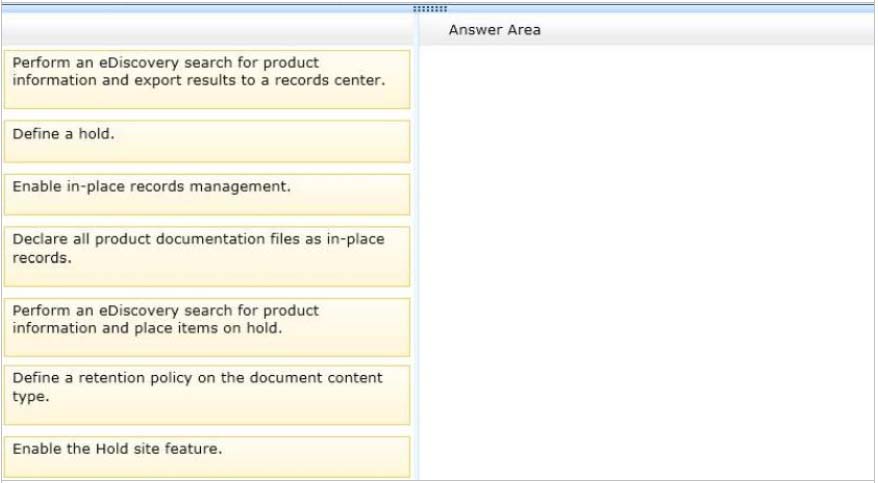
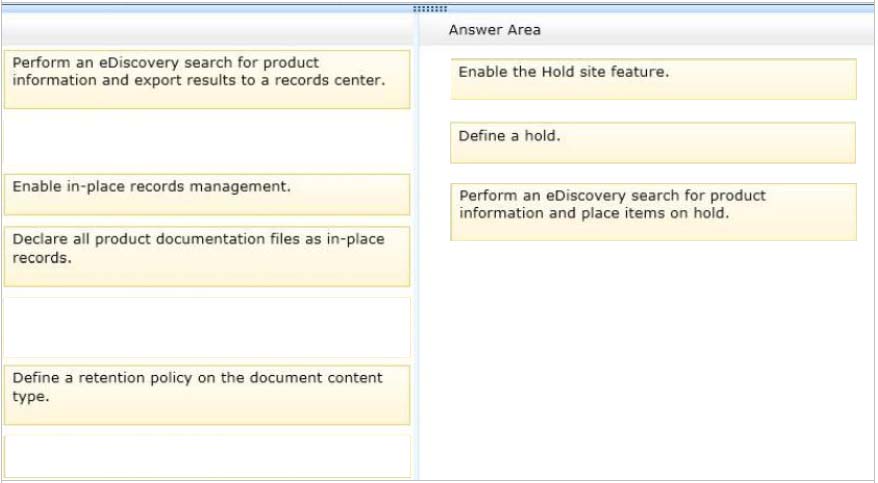
Note:
* An in-place hold is a mechanism for placing content (SharePoint 2013 documents, list items, pages, and Exchange Server 2013 mailboxes) on legal hold while allowing users to continue working with the content and without them being made aware of the hold. If a user edits or deletes content that has been placed on in- place hold, the content is automatically moved to a special location thus preserving the state of the content as it was at the time the hold was placed.
* In-place holds can be placed either at the site or mailbox level, or alternatively, you can use query-based preservation. With query-based preservation, you can define eDiscovery search queries and only content that matches your query will be preserved.
* eDiscovery, or electronic discovery, is the process of discovering (finding) electronically stored information that is relevant to legal matters such as litigation, audits and investigations. Though it is called eDiscovery, the process typically entails more than just the discovery. The main stages of the process are roughly:
1. Discovery Find the relevant content
2. Preservation Place content on legal hold to prevent data destruction
3. Collection Collect and send relevant content to be processed
4. Processing Prepare files to be loaded into a document review platform
5. Review Attorneys determine which content will be provided to opposition
6. Production Provide relevant content to opposition
The SharePoint 2013 eDiscovery functionality focusses on the first three stages.
* Site holds
SharePoint preserves content on the site level. When you preserve a site, its lists, libraries, and subsites are preserved. If you preserve a root site collection, all documents, pages, lists, and subsites in that site collection are preserved.
To hold a site, create a Discovery Case in the eDiscovery Center. A case is a container for all of the queries, content, and preservations associated with specific litigation. After you create the case, create a Discovery Set to specify the site. To validate the site, just enter its URL address.

Hi! Do you need help with this question ?
- Why isn't the A the right answer?
- Traducir la pregunta al español
Contributor get free access to an augmented ChatGPT 4 trained with the latest IT Questions.
Question #18
An organization uses SharePoint Server collaboration sites for all projects. Each project has a unique site. Project team members have Contribute permission levels to each project site of which they are members.
Sites for completed projects must meet the following requirements:
The project team members must be able to access files.
They must be prohibited from editing or deleting files.
They must not be able to change site permissions.
You need to configure the SharePoint environment to meet the requirements.
Which three actions should you perform in sequence? (To answer, move the appropriate actions from the list of actions to the answer area and arrange them in the correct order.)
Select and Place:
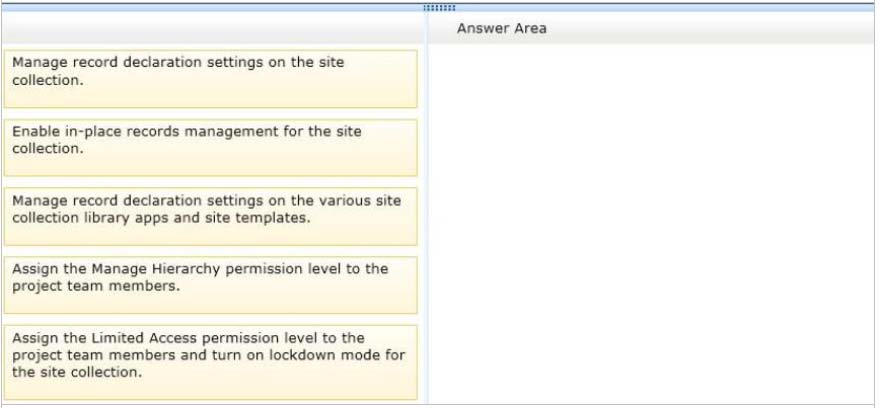

Note:
* The Records Center was introduced in 2007 as a SharePoint site that served as a conventional records archive. Content from all over the enterprise can be submitted to a Records Center and then routed to the appropriate place where it picks up the right permissions and policies, such as expiration and auditing.
Incorrect:

You must have the Manage Permissions permission to configure site permissions. In SharePoint Server, by default only the Full Control and Manage Hierarchy permission levels include this permission.

Hi! Do you need help with this question ?
- Why isn't the A the right answer?
- Traducir la pregunta al español
Contributor get free access to an augmented ChatGPT 4 trained with the latest IT Questions.
Question #19
An organization is deploying a SharePoint farm that will provide a records-management solution.
Users must be able to perform the following actions:
✑ Create in-place holds on content stored in SharePoint and in Microsoft Exchange 2013.
✑ Search for content and place holds based on the search query.
You need to create a site collection that meets the requirements.
Which type of site collection should you create? (To answer, select the appropriate template in the answer area.)
Hot Area:
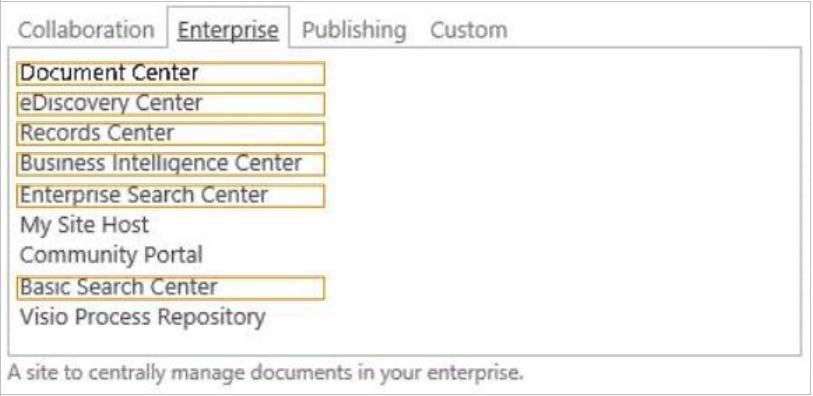
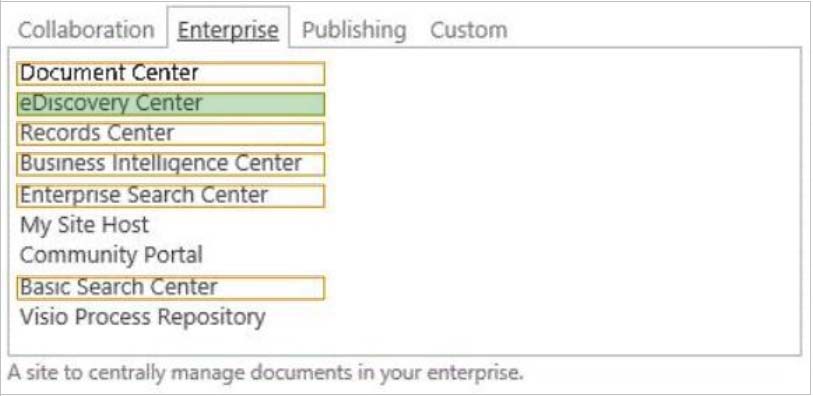
Note:
* Site holds
SharePoint preserves content on the site level. When you preserve a site, its lists, libraries, and subsites are preserved. If you preserve a root site collection, all documents, pages, lists, and subsites in that site collection are preserved.
To hold a site, create a Discovery Case in the eDiscovery Center. A case is a container for all of the queries, content, and preservations associated with specific litigation. After you create the case, create a Discovery Set to specify the site. To validate the site, just enter its URL address.

Hi! Do you need help with this question ?
- Why isn't the A the right answer?
- Traducir la pregunta al español
Contributor get free access to an augmented ChatGPT 4 trained with the latest IT Questions.
Question #20
An organization has a SharePoint intranet site.
Documents and other files do not currently appear in search results until the day after they are uploaded to the intranet site.
You need to configure the Search service application to ensure that documents appear in search results within one hour of being uploaded to the site.
Which three actions should you perform in sequence? (To answer, move the appropriate actions from the list of actions to the answer area and arrange them in the correct order.)
Select and Place:
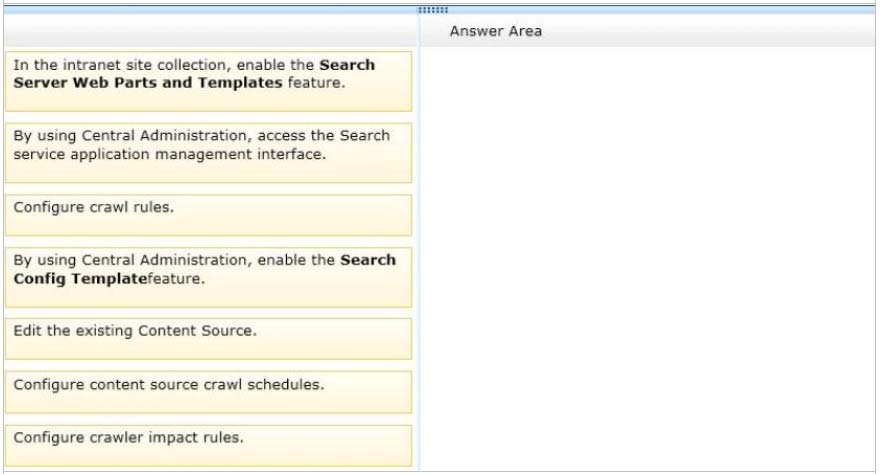
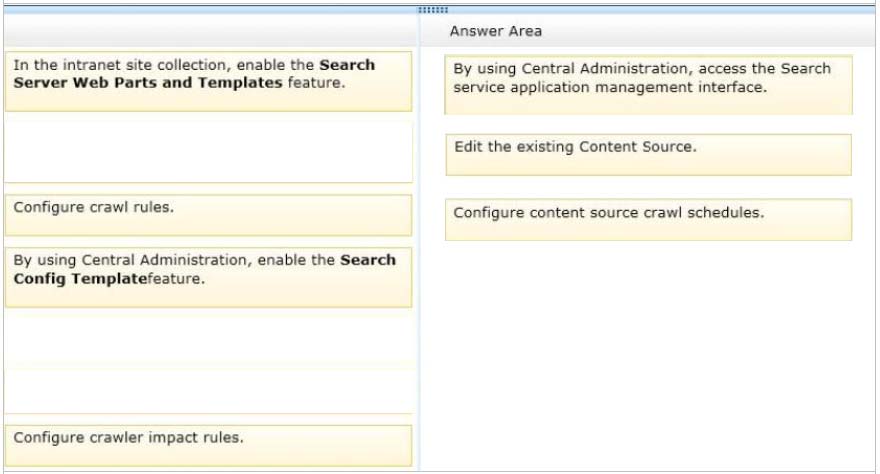
Note:
(Step 1) 1. Open Central Administration web site.
2. Click on the Manage service applications link
3. Click on the Search Service Application
(Step 2) 4. Click on the Content Sources link
(Step 3) 5. Click on the Local SharePoint sites cell and in the page on the right side you can see the Crawl Schedules.
You can see two item: Full Crawl and Incremental Crawl
1. Use the Create Schedule link to create a new Crawl Schedule
2. Click the OK button on the page
Reference: SharePoint 2010 Create Crawl Schedule

Hi! Do you need help with this question ?
- Why isn't the A the right answer?
- Traducir la pregunta al español
Contributor get free access to an augmented ChatGPT 4 trained with the latest IT Questions.
All Pages
